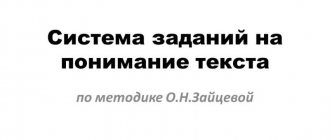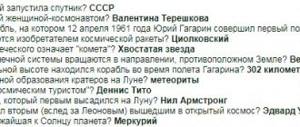A minute of penmanship can be educational and interesting
A minute of penmanship can be educational and interesting
In Ozhegov’s explanatory dictionary “Cleanmanship in school teaching: teaching beautiful, clear writing.”
How to make a moment of penmanship educational and interesting, so that children have a desire to write letters beautifully and correctly. To do this, you need to pay great attention to the structure and methodology of conducting a minute of penmanship. Dembitskaya Natalya, Obukhova Ekaterina and Bakulina Galina in the article “Structure and methodology of conducting a minute of penmanship” divide the minute of penmanship into 2 stages - preparatory and executive.
The preparatory stage consists of two parts:
1) determination and formulation by students of the topic of a minute of penmanship;
2) children drawing up a plan for upcoming actions to write the letter and its elements.
I would especially like to pay attention to the exercises of the preparatory stage. At this stage, the process of intellectual development in children accelerates and linguistic knowledge, skills, and abilities are formed.
The first group of exercises is to compile the characteristics of the desired letter and the sounds that it stands for. Example of a task: “Decide the letter that we will write during the penmanship minute; it is in each of these words (the words are written on the board: raccoon, net, hedgehog, pencil case) and can divide them into two equal groups. What letter is this? What two groups can she divide these words into?” Sample answer: “Today, during the penmanship minute, we will write the letter e. It is found in each of these words. But in the words net, pencil case, it denotes the sound [e]. This is the first group. In the words raccoon, hedgehog, there are two sounds [th], [e] - this is the second group.”
The second group of exercises is the implementation of incomplete phonetic analysis. Example of a task: “Read the words written on the board (paper, weight, row). Determine the letter that we will write today during the penmanship minute. In one of the words it denotes a paired voiced soft consonant sound. What letter is this? What word is it in? Possible answer: “Today we will write the letter g. It is found in the word girya and denotes a paired voiced soft consonant sound in it.” Completing this type of task begins with searching for a letter in one word, consisting of no more than three or four letters. Gradually, students move on to finding the letter in a word consisting of more letters. Further complication is achieved by gradually increasing the number of initial words, one of which contains the desired letter. Words are selected in such a way that each of them contains a letter that would denote a sound that differs from the desired one in just one indicator.
The third group of exercises is the analysis of words by composition. Example of a task: “Identify the letter that we will write during the penmanship minute. It is present at the root of each of these words. What letter is this?” Source words: sourdough, echo, meaty. Sample answer: “Today we will write the letter c. It is found in the root of the word kvass; at the root the voice of the word is an echo; at the root of the word meat is fleshy.” The selection of words in the exercises of this group begins with two units, each of which has one or two components. The number of words gradually increases and their composition becomes more complex.
The fourth group of exercises is conducting a vocabulary dictation in a non-traditional form. Example of a task: “Read these words aloud. Determine which letter we will write during the penmanship minute. It denotes the same spelling in all nouns of a given series: children's, reed, ladder, messenger, answer, terrain, difficult. What letter is this?” Possible answer: “Today we will write the letter t. In all nouns of this series: reed, ladder, messenger, terrain, it is an unpronounceable consonant.” The selection of words in the exercises of this group begins with two or three units of one part of speech. The number of initial words and the variety of parts of speech gradually increases.
The fifth group of exercises is conducting a vocabulary dictation in a non-traditional form of a complicated nature. Words with missing spellings are written on the board: holiday... nik, st... face, heart... tse, ur... zhay, ch... nil, s... tank, n... zina, star... ny, l... tso. Assignment: “Name the letters that we will write during the penmanship minute. With their help, you can divide these words into equal groups. What letters are these? On what basis did you divide the words into groups? Suggested answer: “Today we will write three letters: d, o, i. The letter d is an unpronounceable consonant in the words holiday, heart, starry. The letter o represents an unverified unstressed vowel in the words capital, harvest, dog. The letter is an unstressed vowel in the roots of the words face, repair, lowland. The words are divided into three equal groups according to spelling patterns.”
The sixth group of exercises is the implementation of incomplete phonetic analysis and analysis of words by composition. Example of a task: “Decide the letter that we will write during the penmanship minute. It is found in the root of one of these words (rubber band, closed, whale) and denotes a paired dull soft consonant sound in it. What letter is this? What word is it in? The conditions for compiling and performing exercises in this group are the same as in the second.
The seventh group of exercises is the implementation of incomplete phonetic analysis, analysis of words by composition, morphological analysis in a non-traditional form. The words are written on the board: lamp, forest, flew away. Teacher’s task: “Decide the letter that we will write during the penmanship minute. It is located at the root of the verb and denotes an unpaired voiced soft consonant sound. What letter is this? What word is it in? Work in the exercises of this group begins with two words of different parts of speech and their composition of the same type. Then two words of different parts of speech and different composition are selected. Next, the number of words of different parts of speech with a complicated composition and the number of letters being searched gradually increase. An example of such a complicated exercise. The words are written on the board: old...st, p...went, n...vinky, custard. Assignment: “Read the words written on the board. Name the letters that we will write during the penmanship minute. There are two of them. The first is found in the prefix of a verb, in the root of a plural noun, in the suffix of a singular noun, at the end of an adjective. The second letter denotes a paired voiced solid consonant sound and is located at the root of the word, which contains all the components. What letters are these?” For this kind of exercise, a group of words is first selected, which can be divided into two equal parts, each of which contains two words. The number of words intended for grouping and the number of parts into which they can be divided gradually increases. A more complex version of this group are exercises to increase spelling vigilance with elements of cipher, code, etc. Example of a task. The words are written on the board: Saturday, trouble, coat, forest, dog, birch, sand, eye, work, window and the code for them: 1-4-1. The teacher asks the children: “Decipher these numbers (1-4-1), using only words from the dictionary written in this row, and applying the rule about the gender of nouns. If you correctly group the words in accordance with the code, then in each word of the second group you will find the letter you are looking for. What letter is this? What words does it appear in? Possible answer: “Today we will write the letter b. It is present in all words of the second group, which consists of feminine nouns: birch, Saturday, dog, work. The first group includes the masculine noun sand, the third group includes the neuter noun coat. Hence the code: 1-4-1.” The next round of complication is carried out by completing tasks where children first identify the pattern (mechanism) of determining the letter intended by the teacher, and then independently search for it. This intellectual work is accompanied by no less important and more intense (than in previous exercise groups) speech activity, since students not only must justify their actions in searching for a letter, but also pre-formulate a program for these actions.
The eighth group of exercises is the selection of synonyms. Example of a task: “Look carefully at this entry: doctor - doctor call - ? roar – ? Hurricane - ? Having correctly formulated and completed the task, you will determine the topic of a minute of penmanship.” Suggested answer: “For the words in the left column, you need to select words that are close in meaning and ending with the letter h: doctor - doctor, roar - cry, call - cry, hurricane - tornado. All the words in the right column contain the consonant h. This means that today during the penmanship minute we will write the letter h.” The ninth group of exercises is the selection of antonyms. Example of a task: “Look carefully at this entry: large - small dry - ? war - ? deep – ? old - ? iron - ? solid - ? If you correctly formulate and complete the task for it, you will find out which letter we will write during the penmanship minute.” Suggested answer: “For the words in the left column, you need to choose words that are opposite in meaning, starting with the letter m: big - small, dry - wet, war - peace, deep - shallow, old - young, iron - wrinkle, hard - soft. This means that today we will write the letter m.” If necessary, you can increase the spelling significance in the exercises of the eighth and ninth groups. To do this, an ellipsis is placed in place of the spelling in the original words and their recording is checked. For testing, it is advisable to choose a method that also involves verbal and mental activity. For example, invite schoolchildren to talk about the spelling of these words, having previously grouped them by spelling.
To obtain a high effect, in addition to the indicated conditions for completing tasks for specific groups of exercises, it is necessary to comply with the general requirements for all groups of exercises of the first part of the preparatory stage. These include:
1. From lesson to lesson, the degree of difficulty of tasks in each group of exercises gradually increases.
2. The content of the exercises is connected with the topics of the Russian language being studied, which makes it possible to increase the efficiency of their assimilation.
3. Each task provides for the active verbal and mental activity of schoolchildren, during which they create a story-reasoning, a story-inference, giving an idea of the actions taken by the student to find the letter intended for writing.
When creating them, the teacher draws the children’s attention to the correct construction of sentences and the logic of presentation of thoughts.
The second part of the preparatory stage, like the first, requires a gradual complication of the active and conscious activities of students. Children do not reproduce a ready-made example of writing a letter and its elements (letters and their elements). They first, in the process of verbal and mental activity, master the order of writing letters proposed by the teacher, defining and formulating out loud its pattern. The recording pattern changes for each lesson, providing a gradually increasing level of difficulty, which is created in two ways. The first way: the teacher gradually complicates the letter designs (letters and their elements) in the chain he proposes. There are a variety of options available here:
1) ... (pattern: a short inclined line alternates with a long inclined line with a curve at the bottom);
2) ... (pattern: the lowercase letter a alternates with long oblique lines, the number of which increases by one with each repetition);
3) b 0 bb 0 bbb 0 ... (pattern: lowercase letters b, the number of which increases by one with each repetition, alternate with an oval);
4) ... (pattern: lowercase letters c, the number of which decreases by one with each repetition, alternate with a long slanted line with a curve at the bottom);
5) ...(pattern: lowercase letters y, the number of which decreases by one with each repetition, alternate with short oblique lines with a curve at the bottom, the number of which increases by one with each repetition);
6) ra rb rv ... (pattern: the lowercase letter r alternates with letters of the alphabet in order);
7) ma my mb mu ... (pattern: the lowercase letter m alternates with letters of the alphabet in direct and reverse order);
 obl forehead obl forehead ... (regularity: the lowercase letter b is written with the letters o and l, which change places in each link of the chain);
obl forehead obl forehead ... (regularity: the lowercase letter b is written with the letters o and l, which change places in each link of the chain);
9) oo oo oo oo oo ... (pattern: the chain consists of the letters o and e; with each repetition their number increases by one). Etc.
The second way to increase complexity is to involve students in composing a chain of letters. A variable approach is possible here, which is directly dependent on the degree of independence of schoolchildren in this work: the option of partial participation and the option of complete independence in composing a chain of letters. In the partial participation option, the pattern of alternating letters in the chain is determined by the teacher. In this case, the students have to work related either to the perception of the pattern indicated by the teacher in complicated conditions, or to the reconstruction of the order of letters specified by the teacher.
The following types of activities are possible:
1) listening to the pattern proposed by the teacher and writing a chain of letters in accordance with it in the specified order. For example, the teacher suggests: “Make a chain of lowercase letters a, o, t so that in each link the vowels come before the consonant and change places with each other” (aot oat aot oat...);
2) independent identification of the pattern of writing letters in a given row; writing a chain with a change in the original order of letters to another, related to the teacher’s assignment. For example, the teacher suggests determining the order of letters in the following row: abu, uab and writing it, alternately increasing the number of vowels in each link by one (aabu, uuab, etc.);
3) independent identification of the pattern of recording in the chain given by the teacher; writing a chain with changing the order given by the teacher to one invented independently, followed by voicing the compiled pattern. The option for complete independence involves students drawing up a pattern of alternating letters and voicing it.
Calligraphy classes develop a sense of rhythm and regularity, and increase the intelligence of students. The effects of exercise may appear at different times. For some, the influence of calligraphy is felt immediately, for others it matures later. When planning a lesson, it is important not to skip this stage of the lesson, but to try to make it interesting and entertaining.
Literature
1. https://slovarsbor.ru/
2. https://www.nnre.ru/jazykoznanie/metodika_intellektualnogo_razvitija_mladshih_shkolnikov_na_urokah_russkogo_jazyka/p9.php
3. https://kalligrafinja.ru/blog/shkolnye-chistopisanie-i-kalligrafiya-shodstvo-i-razlichiya-chast-2.html
Similar articles:
News → Competition “Do you want to be a leader? Be it!”
News → “Do you want to be a leader? Be it!”
Information for class teachers → regulations on the regional correspondence competition If you want to be a leader, be one
School League → index





